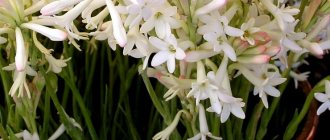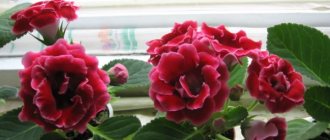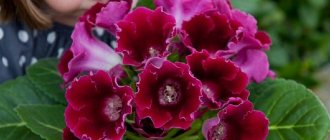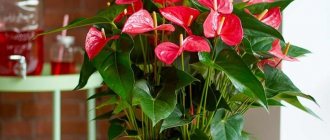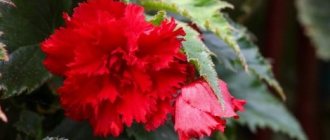Author: Elena N. https://floristics.info/ru/index.php?option=com_contact&view=contact&id=19 Category: Houseplants Published: January 17, 2019Last edits: January 11, 2021
- Growing conditions
- Growing from seeds
Did you know that the first gloxinias brought from South America in the 18th century were rhizomatous, and tuberous species were brought from the same places only in the last century? And what exactly was tuberous gloxinia that became the basis for the development of many beautiful varieties of this indoor crop? What’s also interesting: Gloxinia is listed in botanical reference books as Sinningia beautiful, although Gloxinia and Sinningia are two different, albeit related crops: Sinningia is a rhizomatous plant, and Gloxinia beautiful is a tuberous plant. From this article you can learn how to care for gloxinia during the growing season, how to stimulate its flowering and how to then organize a dormant period for the plant.
Planting and caring for gloxinia
- Flowering: from March to late summer.
- Lighting: bright diffused light with 12-14 hours of daylight.
- Temperature: during the growing season - normal for residential premises, during the dormant period - about 10 ˚C.
- Watering: during the growing season - regular, but moderate, by bottom watering; from August the plant prepares for a dormant period, and watering should become less frequent.
- Air humidity: high, but spraying the leaves is strictly not recommended; it is better to keep containers of water around the plant.
- Feeding: during the active growing season, once every 10 days with a solution of complete mineral fertilizer for flowering indoor plants.
- Pruning: in May or June, after the end of the first flowering, and in the fall, before the start of the dormant period.
- Dormant period: from late October to late February.
- Transplantation: at the end of the dormant period.
- Reproduction: seeds, leaf cuttings.
- Pests: thrips, cyclamen and spider mites.
- Diseases: gray rot, viral infections.
Read more about growing gloxinia below.
plant (lat. Gloxinia) , which received its name in honor of the Alsatian doctor and botanist Benjamin Peter Gloxinn, forms a genus in the Gesnerieceae family. Gloxinia flowers are perennial tropical herbs and shrubs. Gloxinia is native to Central and South America, where it grows in the deciduous forests of Brazil and Peru, in the rocks of Mexico, in the Andes or on river banks. Another name for gloxinia - Sinningia (lat. Sinningia) - was given to it in honor of Wilhelm Sinning, a gardener at Boston University, who devoted himself to the selection and hybridization of gloxinia. Thanks to his efforts, hybrid or domestic gloxinia (sinningia) appeared in floriculture, represented by many varieties and hybrids.
Photo
What does domestic gloxinia look like? Photo of a flower.
Indoor plants gloxinia: photos of flowers.
Sinningia: photo.
Gloxinia seeds: photo.
Botanical description, species
Indoor gloxinia is a tuberous perennial with a short stem and juicy velvety leaves of rich green color. The same velvety bell-shaped flowers, simple or double, pink, red, white, purple, speckled, frilly or two-colored, reach 5 cm in length and 7 cm in diameter. Numerous gloxinia seeds are very small. Of the 25 species that exist in nature, only Gloxinia royal and Gloxinia beautiful became the basis for breeding work.
Royal Gloxinia (Gloxinia regina)
It is a flower with thickened stems up to 10 cm in height. Dark green pubescent leaves, with silver veins on the upper side and reddish on the bottom, broadly oval, arranged oppositely in 4-6 pieces, from 15 cm to 20 cm long. Peduncles are long, bell-shaped drooping flowers of a dark purple hue reach a length of 5 cm , and in diameter 7 cm.
- Maranta - care, photos, types
Gloxinia speciosa
A herbaceous plant with broadly oval, evenly green leaves narrowed at the base on long stalks. Flowers of various shapes, depending on the variety, including double gloxinia, white, red, violet, blue, pink, purple, there are forms with a white rim around the edge.
Like any plant, gloxinia has some features:
- after flowering, the above-ground part of the flower dies, and it is important to wait until this process spontaneously completes;
- before the dormant period, gloxinia requires feeding with fertilizers that do not contain nitrogen - potassium monophosphate, for example;
- a gloxinia pot requires a decent size, for an adult plant - at least 15 cm in diameter;
- if you want your gloxinias to bloom all year round, arrange a rack or a warm shelf for them with additional lighting for 14 hours a day.
Caring for gloxinia at home
Growing conditions
If you decide to grow gloxinia, provide it with a spacious place where bright, diffused light will fall: it needs twelve to fourteen hours of daylight, so during long nights, be prepared to provide the plant with additional lighting. There is an easy way to tell if a flower has enough light: if the dark green leaves are horizontal and the stem is short, there is no need to worry, but if the leaves and stem stretch upward, then the plant is not getting enough light.
However, remember: caring for gloxinia involves, first of all, protection from direct sunlight, which is detrimental to the plant.
And one more important point: no drafts! If you decide to keep the flower on the windowsill, you will have to forget about frequent ventilation. And the air humidity that gloxinia needs will have to be increased artificially by placing containers of water around the flower, since the plant does not like moisture on the leaves and flowers, which cannot be avoided when spraying.
As for the temperature, during the growing season gloxinia will be satisfied with the usual room temperature for this time of year, but during the dormant period it needs coolness - about 10 ºC. Observe the plant, and it will tell you what changes in care it needs: overheating causes gloxinia leaves to stretch upward, but if the leaves are lowered below the edge of the pot, the flower freezes.
Watering
During the growing season, water gloxinia in a tray or by overhead watering, being careful not to wet either the leaves or flowers. Between waterings, the top layer of the substrate should dry out. At the end of August, the intervals between waterings are increased so that the plant gradually enters a dormant period until the end of October. Both overwatering and underwatering should be avoided. Water the gloxinia with settled or filtered water a degree or two warmer than room temperature.
- Bacopa: growing from seeds, types and varieties
Fertilizer
During the period of active growth, gloxinia is fed once a decade with a complete complex fertilizer for ornamental flowering plants. In mid-August, feeding is stopped. If you neglect the application of fertilizers, problems may arise with both growth and flowering: growth slows down, the buds become smaller, the color of the flowers fades, causing the decorative appearance of the plant to suffer, and the flowering period becomes much shorter.
Sometimes the plant suffers from a lack of boron. This becomes noticeable in the summer with maximum daylight: deep notches appear along the edge of the leaf blade. In this case, you need to foliar feed gloxinia with a two percent borax solution. And let me remind you that excess fertilizer is much more dangerous for the plant than its lack, so try to observe moderation in this matter.
Landing
Every year, at the end of the rest period, the gloxinia is transplanted into a new pot. The soil mixture used is the same as for begonias and violets. It can be purchased at the store, or you can make it yourself from two parts of leaf, one part of humus soil and one part of sand.
So, in February, gloxinia tubers are taken out of the pot along with a lump of earth and transferred to a new pot, slightly larger than the previous one, in which a layer of drainage is first laid, and a layer of soil is placed on top of it. Then the substrate is gradually added and compacted. As a result, the tuber should only be buried halfway into the substrate. The same principle applies to the initial planting of gloxinia.
Gloxinia has faded - what to do?
When gloxinia has bloomed (usually this happens in May-June), cut off the stem and almost all the leaves, leaving only 2-4 lower leaves on the plant, in the axils of which stepsons will soon appear, of which you will leave a couple of the strongest ones and remove the rest . At this time, it is advisable to fertilize the flower with fertilizers for growth, and a month later, when the buds appear, you need to introduce fertilizers for flowering.
The second bloom most likely won't be as lush as the first, but that's normal. Sometimes gloxinia blooms all summer, and the question of re-blooming disappears. When gloxinia has completely faded, you need to gradually reduce watering and stop feeding, wait until the leaves turn yellow and dry, then cut off the tops, leaving a stump of 1-2 cm above the tuber.
Transfer
Every year, at the end of the rest period, the gloxinia is transplanted into a new pot. The soil mixture used is the same as for begonias and violets. It can be purchased at the store, or you can make it yourself from two parts of leaf, one part of humus soil and one part of sand. So, in February, gloxinia tubers are taken out of the pot along with a lump of earth and transferred to a new pot, slightly larger than the previous one, in which a layer of drainage is first laid, and a layer of soil is placed on top of it. Then the substrate is gradually added and compacted. As a result, the tuber should only be buried halfway into the substrate. The same principle applies to the initial planting of gloxinia.
Gloxinia in winter
to the question “how to store gloxinia after flowering” :
- Gloxinia, pruned for the winter, is stored in a cool, dark place until the end of February. Gloxinia is moistened in winter only 1-2 times a month so that the tubers do not dry out. Gloxinia can overwinter under a bathtub or in an insulated loggia;
- the second way to preserve gloxinia during the dormant period involves removing the tuber from the pot, and since at the end of January or beginning of February you will still have to transplant the gloxinia into a new pot with a new substrate, so why not remove the tuber from the pot in the fall? The extracted tuber is cleaned of soil residues, placed in a plastic bag with a zipper, vermiculite and substrate are added to the bag in a 1:1 ratio, the zipper is fastened and the bag is placed for winter storage in the vegetable section of the refrigerator. Now you don’t have to worry that the tuber may dry out without watering after three to four months of dormancy.
You don’t have to worry about how to preserve young gloxinia grown from seeds in winter: it is left in a pot and watered moderately so that the small, still weak tuber does not die over the winter.
- How to grow balsam from seeds (video)
Reproduction of gloxinia at home
Growing from seeds
The rich assortment of gloxinia seeds in specialized stores inspires optimism for those who want to test themselves as a breeder. But don't expect too much from this experiment. Growing gloxinia from seeds begins with purchasing seed material - thank God, this is not a problem today - and it is better to purchase granulated seeds. The packaging usually indicates a germination period of 4-6 months, or even 9-10, but this is only if you sow in winter or autumn. If you do this in March, the process will go much faster.
You can use purchased greenhouses for sowing, or you can make a greenhouse yourself: loosely place and soak peat tablets in a deep plastic container with a lid, and spread the granules onto them without embedding them in the soil. Make several holes in the lid for ventilation. Place the greenhouse with the seeds in a bright, warm place with a temperature of approximately 22-23 ºC and for one and a half to two weeks, carefully moisten the soil as necessary and wait for the emergence of seedlings. When the sprouts sprout and get stronger, plant them together with peat tablets in disposable cups, and after a while in permanent pots.
Leaf propagation
Whatever they say, vegetative propagation is usually more reliable than seed propagation, and if you do not have a particular reason to grow plants from seeds, use the vegetative method, and we will tell you how to grow gloxinia from leaf cuttings. Since Gloxinia leaves are quite large, take either the smallest leaf or divide a large leaf into fragments. The leaf blade must be cut across, parallel to the transverse veins; the leaf petiole is also cut off, leaving no more than 2 cm. Use a sharp tool for cutting, otherwise the edges of the leaf or its fragments may rot.
Plant the fragments in pots with a light, slightly moist substrate and place them in a greenhouse or cover them with a plastic bag - for a month you will not have to water the soil or ventilate the greenhouse, and after a month the rooted fragments should be gradually accustomed to life outside the greenhouse, opening the plastic for a short time . The greenhouse with the rooting parts of gloxinia should be kept in a well-lit, warm place.
Business to replenish the family budget
Today, in Europe, America and Russia, the sale of gloxinia by ordinary gardeners has become widespread . This practice originated in the West in the 70-90s. The fact is that at that time only one person worked in the family, most often a man. Women did housework. Some housewives came up with the idea of capitalizing on their hobby. Breeders sold gloxinia to each other at agricultural fairs and meetings of flower growers' clubs.
Today, sales practices have changed somewhat. You can purchase blooming gloxinia from your own hands in specialized communities on social networks and on free classifieds websites. And the old fashioned way, on the street at the subway exit or at a spontaneous market. The average price for one flowering bush is 200-300 rubles.
Pests and diseases
Unfortunately, gloxinia, like other flowers, suffers from diseases, which are usually the result of improper care. Gloxinia is affected by gray rot, which appears as brown spots on the leaves. It must be combated by treating the plant with a fungicide, after removing all damaged areas. But most often the plant suffers from root rot: the roots turn dark brown, the stem rots at the base and the plant dies. This happens from constant waterlogging of the roots or watering the plant with too cold water. In addition to the diseases mentioned above, protect gloxinia from late blight, blackleg, powdery mildew and fungal diseases. For preventive treatment, use phytosporin; for treatment, use foundationazole.
Viral diseases will also not bypass gloxinia, especially if thrips, cyclamen or spider mites infest it, so try to avoid this.
The cyclamen mite can only be seen under a microscope; with the naked eye you can only detect a large accumulation of mites, looking like a layer of dust on the underside of the leaf blade, but if the leaves of the plant begin to deform and thicken, and curl down at the edges, if the stem twists, the buds wither , the petals of the flowers are deformed, and the tops of the shoots dry out - this means that the flower is occupied by cyclamen mites.
The spider mite is also almost invisible; it also settles on the underside of the leaf and feeds on the cell sap of the plant. You can tell that you are dealing with a spider mite by the white dots that later turn into yellow-brown spots, or by the thin web if the infestation is already at a very strong stage.
The presence of thrips is revealed by light dots, streaks and spots on the leaves and a silvery sheen of undamaged areas of the leaves, which dry out over time, turn brown on the underside, and the edges begin to curl upward. Thrips larvae go into the soil, so to combat the pest you will have to change the top layer of the substrate, or better yet replace it with a new one, but before that, triple treat the plant with insecticides (actara, karbofos, fitoverm, actellik) at intervals of a week. The same measures are also effective in the fight against ticks, but the soil will not have to be changed.
